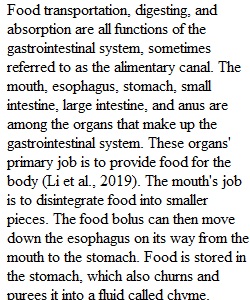


Q Module 7Critical Thinking Assignment Metabolism Read the required article from your readings titled: Metabolic effects of dietary carbohydrates: The importance of food digestion. The digestive system is designed to process food into molecules that can be absorbed and utilized by the cells of the body. The purpose of this paper is to demonstrate understanding of the body’s ability to utilize nutrients through the processes of digestion and absorption. To do so, write a paper following a bite of food from the mouth through the digestive tract. Address the following points in your paper: • Identify the structure and function of the organs of the gastrointestinal tract and the accessory organs of digestion. • Differentiate between mechanical digestion and chemical digestion, including a discussion of the role of enzymes and hormones in the digestive process. • Summarize your information by comparing and contrasting the digestion and absorption of carbohydrates, fats, and proteins. Requirements: Create a paper. Your paper should be 2-3-pages in length and conform to APA guidelines in the CSU Global Writing Center. Include at least two scholarly references in addition to the course textbook. The CSU Global Library is a good place to find these references. Rubric Mod 7 CT Mod 7 CT Criteria Ratings Pts This criterion is linked to a Learning OutcomeContent 15 to >12.0 pts Meets Expectation Demonstrates strong or adequate knowledge of the digestive system, nutrition, and metabolism; correctly represents knowledge from the readings and sources. 12 to >9.0 pts Approaches Expectation Some significant, but not major, errors or omissions in demonstration of knowledge. 9 to >6.0 pts Below Expectation Major errors or omissions in demonstration of knowledge. 6 to >0 pts Limited Evidence Fails to demonstrate knowledge of the materials. 15 pts This criterion is linked to a Learning OutcomeSources / Examples 10 to >8.0 pts Meets Expectation Sources or examples meet required criteria and are well chosen to provide substance and perspectives on the issue under examination. 8 to >6.0 pts Approaches Expectation Sources or examples meet required criteria, but are less than adequately chosen to provide substance and perspectives on the issue under examination. 6 to >4.0 pts Below Expectation Sources or examples meet required criteria, but are poorly chosen to provide substance and perspectives on the issue under examination. 4 to >0 pts Limited Evidence Source or example selection and integration of knowledge from the course are clearly deficient. 10 pts This criterion is linked to a Learning OutcomeDemonstrates college-level proficiency in organization, grammar and style. 5 to >4.0 pts Meets Expectation Project is clearly organized, well written, and in proper format as outlined in the assignment. Strong sentence and paragraph structure; few errors in grammar and spelling. 4 to >3.0 pts Approaches Expectation Project is fairly well organized and written, and is in proper format as outlined in the assignment. Reasonably good sentence and paragraph structure; significant number of errors in grammar and spelling. 3 to >2.0 pts Below Expectation Project is poorly organized; does not follow proper paper format. Inconsistent to inadequate sentence and paragraph development; numerous errors in grammar and spelling. 2 to >0 pts Limited Evidence Project is not organized or well written, and is not in proper paper format. Poor quality work; unacceptable in terms of grammar and spelling. 5 pts This criterion is linked to a Learning OutcomeDemonstrates proper use of APA style 5 to >4.0 pts Meets Expectation Project contains proper APA formatting, according to the CSU Global Writing Center, with no more than one significant error. 4 to >3.0 pts Approaches Expectation Few errors in APA formatting, according to the CSU Global Writing Center, with no more than two to three significant errors. 3 to >2.0 pts Below Expectation Significant errors in APA formatting, according to the CSU Global Writing Center, with four to five significant errors. 2 to >0 pts Limited Evidence Numerous errors in APA formatting, according to the CSU Global Writing Center, with more than five significant errors. 5 pts Total Points: 35 PreviousNext
View Related Questions